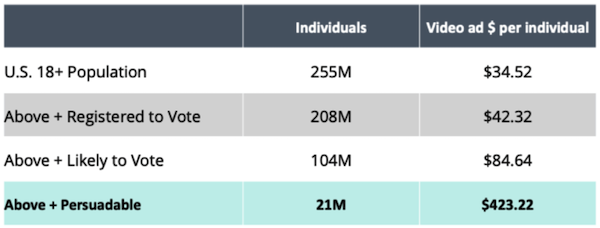Articles
What Everyone Can Learn
From Political Ad Campaigns
With next-generation planning tools like Cross Screen Media’s ScreenImpact, see how we analyzed the close Senate race in Georgia that showed two very different approaches to targeting swing voters.
December 13, 2022
Once every two years, something remarkable happens in the advertising world. During a short, two-month period, a massive political ad machine awakens and spends billions of dollars to engage and mobilize voters with the hopes of persuading them to vote for, or against, candidates and important issues across our nation.
On the surface, it might seem like the advertising world at large might not have a lot to learn from the political world. Afterall, political campaigns essentially start over every two years, their entire war chest must be spent before election day and there’s no market share for second place. But in reality, political spending can teach us a lot about planning, activating and measuring effective video ad campaigns.
Political advertising holds a special place for us here at Cross Screen Media. It’s where our company began, and the lessons it has taught us about local, cross-screen campaigns are something we practice in the non-political world every day. For example, we recently did an analysis of the close Senate race in Georgia that showed two very different approaches to targeting swing voters.
Here are the top three takeaways every video advertiser can learn from political ads:
Your true audience must be
at the center of your planning
Political advertisers know more than anyone that when it comes to successful, targeted advertising, knowing your true audience is everything. The more you know about who you are targeting, where they are and what their consumption habits are, the more you can effectively target them. Not all audiences watch broadcast or cable, and not all of them are accessible via CTV or digital video either.
Political campaigns know the only way to effectively target your audience is drill down into your specific audience segment, then build a comprehensive, cross-screen campaign that will maximize reach while also optimizing efficiency.
In the 2022 election cycle, $8.8 billion was spent on video advertising, but that money wasn’t spent on the population at large, or even on registered voters or those likely to vote. As we see below, this huge sum was spent only on the critical subset of persuadable swing voters that could tip key races in their favor. The average cost per individual was markedly higher at $423 per individual, but the results were well worth the effort in additional planning.

The strongest campaigns
must start at the local level
Political advertising is perhaps the most compelling case for the importance of local geotargeting. Voters who reside inside a voting district are highly valuable, while those just 10 feet outside of a district are irrelevant to that campaign, no matter how many times they are shown ads for the candidates or issues in question. That’s why the strongest political campaigns are hyper-targeted, moving far beyond the typical state, or even DMA designations.
While non-political video advertising doesn’t have to be quite as vigilant in their geotargeting, the same lessons apply. Those who live less than five miles away from a local auto dealer are far more likely to visit the showroom than those who live more than 10 miles away, so why would you target a DMA or zip code that spans 20 miles or more?
Most businesses have a distinct geo footprint, whether you are a regional bank, a local auto dealer, or a municipal hospital center. Spending outside of that footprint is simply money wasted on audiences that won’t travel to your business. In highly competitive markets and industries, it’s too expensive to have missed opportunities and wasteful spending.
Constantly test, learn, and improve— or fall behind
Barack Obama’s 2008 presidential campaign was a literal case study in the benefits for testing, learning and iterating rapidly to achieve a goal. The campaign was famous for testing dozens of different splash pages and subject lines in their email outreach until they found the one combination that converted more voters than any other. Obama was not alone. Many political campaigns employ these iteration tactics to move their messaging to where their audience needs it to be. In fact, we recently published a short case study detailing just that.
With traditional broadcast and cable TV advertising, testing was always possible, but the learning and improving portions of this strategy proved far more difficult due to the lack of accurate measurement.
Fortunately, in today’s cross-screen, Connected TV world, measurement IS possible, allowing brands and agencies to finally see exactly how their campaigns are performing and ensuring that their next campaigns are even better.
The virtuous cycle of identifying your true audience, effective cross-screen planning, real-time measuring and constantly improving is something all advertisers need to take to heart.
Conclusions
Voters sometimes have a love-hate relationship with political advertising. In the run-up to the election, they hate seeing political ads seemingly everywhere. After the election, they love that they all disappear.
But for advertisers, there are many valuable takeaways in those ads. The fact that you see them, notice them and can probably recite some of them from memory is a testament to their effectiveness.
That’s why we here at Cross Screen Media have dedicated ourselves to bringing the lessons of audience targeting, local focus and cross-screen planning and measurement to brands and agencies, especially those outside the political space. You can request a demo of our products and see them in action first hand!





